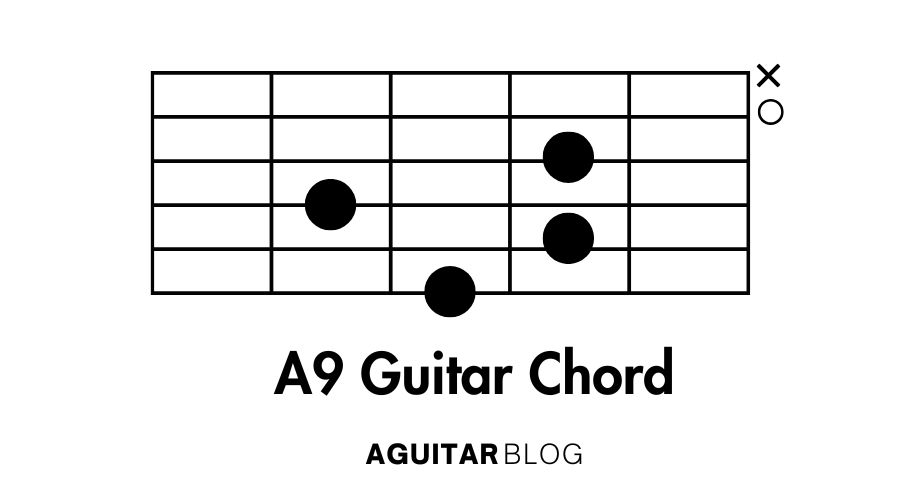The A9 guitar chord is a dominant 9th chord commonly used in various genres, including jazz, blues, and funk. This chord adds a rich, colorful sound that enhances progressions and provides an interesting twist to more traditional chords. It’s built from the dominant seventh chord (A7) with the added ninth note (B), giving it its unique flavor.
Here’s everything you need to know about the A9 guitar chord, how to play it, its variations, and more.
What is the A9 Guitar Chord?
The A9 chord is a dominant 9th chord, meaning it’s a combination of the following notes:
- A (Root)
- C# (Major third)
- E (Perfect fifth)
- G (Minor seventh)
- B (Major ninth)
This chord creates a sense of tension and anticipation, which can resolve nicely to other dominant chords or major chords in a progression.
How to Play the A9 Guitar Chord

Basic Open A9 Chord (Open Position)
The easiest way to play the A9 chord is in the open position:
- Place your index finger on the 2nd fret of the 4th string (D string).
- Place your middle finger on the 2nd fret of the 2nd string (B string).
- Place your ring finger on the 2nd fret of the 3rd string (G string).
- Let the 5th string (A string) ring open.
- Let the high E string (1st string) ring open.
- Strum from the 5th string (A string) down to the 1st string.
This simple version of the A9 chord gives a clean, bright sound.
A9 Barre Chord Version
To play a more versatile A9 chord, you can use a barre chord shape:
- Bar all strings at the 5th fret with your index finger.
- Place your ring finger on the 7th fret of the 4th string (D string).
- Place your pinky finger on the 7th fret of the 3rd string (G string).
- Let the high E string (1st string) ring open.
- Strum all six strings from the 6th string (low E) down.
This voicing is more powerful and allows you to play the chord across the fretboard.
Video Tutorial A9 Guitar Chord
For visual learners, a step-by-step video tutorial can make mastering the A9 Guitar Chord much easier. Here’s a helpful guide for you:
Variations of the A9 Guitar Chord
There are different ways to play the A9 chord with slight variations in voicing, each creating a unique sound:
- A9 (Jazz/Funk Voicing):
- Place your index finger on the 5th fret of the 6th string (low E).
- Place your ring finger on the 7th fret of the 5th string (A).
- Place your pinky finger on the 7th fret of the 4th string (D).
- Place your middle finger on the 6th fret of the 3rd string (G).
- Let the high E string ring open.
This version is often used in jazz, funk, and blues for a fuller, richer sound.
Common Chord Progressions Featuring the A9 Chord
The A9 chord is great for creating tension and resolution in chord progressions. Here are a few common progressions that use the A9 chord:
- A9 – D9 – E9 (A classic 12-bar blues progression)
- A9 – D9 – G9 (Another variation for blues)
- A9 – Bm7 – E7 (A smooth jazz progression)
- A9 – C#m7 – F#9 (Great for modern pop and R&B)
These progressions allow you to move fluidly between dominant chords and create exciting harmonic movement.
Tips for Playing the A9 Guitar Chord
- Begin slowly: If you’re new to the A9 chord, take it slow to ensure that every note rings clearly.
- Proper finger placement: Make sure your index finger is barring the correct strings and that your other fingers are pressing the strings cleanly without muting others.
- Focus on rhythm: The A9 chord works wonderfully in rhythmically complex styles like funk and jazz. Experiment with different strumming patterns and syncopation to make the chord come alive.
- Incorporate slides or bends: In blues and rock, try sliding into the A9 chord or bending notes for a more expressive sound.
Popular Songs Featuring the A9 Guitar Chord
The A9 chord is widely used in genres like jazz, blues, and R&B. Here are some examples of songs that feature the A9 chord:
- “I Got a Woman” by Ray Charles
- “Superstition” by Stevie Wonder
- “Purple Rain” by Prince
These songs demonstrate the versatility and cool, jazzy vibe of the A9 chord.
Related Chords to the A9 Guitar Chord
If you love the A9 chord, here are a few related chords you might want to explore:
- A7: A dominant seventh chord without the ninth, providing a more basic tension.
- Amaj9: A major ninth chord, offering a smoother, more uplifting sound.
- D9: The dominant ninth chord of the IV, often used in progressions with A9.
- E9: The dominant ninth chord of the V, frequently following the A9 in blues and jazz progressions.
Conclusion
The A9 guitar chord is a highly versatile and expressive chord that can elevate your playing, especially in genres like jazz, blues, and funk. Whether you’re playing in the open position or using a barre chord shape, the A9 adds color and tension to your progressions.
Experiment with the A9 chord, practice different voicings, and incorporate it into your songs and progressions to add depth and complexity to your sound. Happy playing!